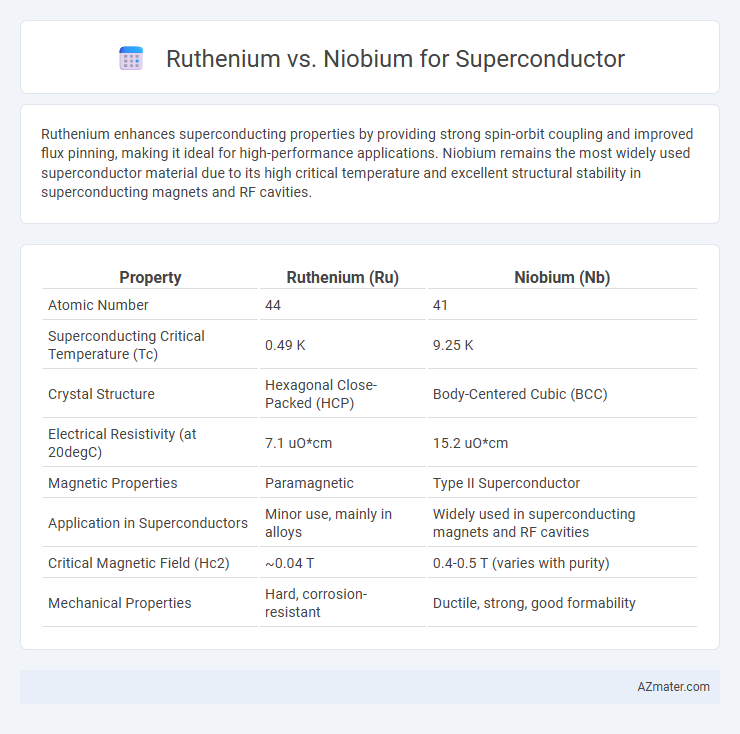Ruthenium enhances superconducting properties by providing strong spin-orbit coupling and improved flux pinning, making it ideal for high-performance applications. Niobium remains the most widely used superconductor material due to its high critical temperature and excellent structural stability in superconducting magnets and RF cavities.
Table of Comparison
| Property | Ruthenium (Ru) | Niobium (Nb) |
|---|---|---|
| Atomic Number | 44 | 41 |
| Superconducting Critical Temperature (Tc) | 0.49 K | 9.25 K |
| Crystal Structure | Hexagonal Close-Packed (HCP) | Body-Centered Cubic (BCC) |
| Electrical Resistivity (at 20degC) | 7.1 uO*cm | 15.2 uO*cm |
| Magnetic Properties | Paramagnetic | Type II Superconductor |
| Application in Superconductors | Minor use, mainly in alloys | Widely used in superconducting magnets and RF cavities |
| Critical Magnetic Field (Hc2) | ~0.04 T | 0.4-0.5 T (varies with purity) |
| Mechanical Properties | Hard, corrosion-resistant | Ductile, strong, good formability |
Introduction to Ruthenium and Niobium as Superconductors
Ruthenium, a transition metal with atomic number 44, exhibits unconventional superconductivity primarily in its ruthenate compounds, such as Sr2RuO4, which display spin-triplet pairing and unconventional order parameters. Niobium, element 41, is widely used as a superconductor due to its relatively high critical temperature around 9.3 K, excellent critical magnetic field, and ductility, making it ideal for applications in superconducting magnets and RF cavities. The fundamental difference lies in niobium's conventional electron-phonon mediated superconductivity versus ruthenium's complex, strongly correlated electron systems that challenge theoretical understanding.
Key Properties of Ruthenium in Superconducting Applications
Ruthenium exhibits notable superconducting properties such as a critical temperature (Tc) around 0.5 K and strong spin-orbit coupling, enhancing its potential in unconventional superconductivity and topological superconductors. Its chemical stability and ability to form complex alloys contribute to robust superconducting phases under extreme conditions. Ruthenium's high electron density and unique magnetic characteristics differentiate it from niobium, which has a higher Tc of about 9.2 K but less spin-orbit interaction, making ruthenium valuable in niche, advanced superconducting applications.
Niobium: The Gold Standard in Superconductivity
Niobium remains the gold standard in superconductivity due to its exceptional critical temperature around 9.3 K and outstanding critical magnetic field, making it ideal for superconducting magnets and RF cavities in particle accelerators. Ruthenium, while useful in some niche superconducting alloys and as a doping agent, cannot match niobium's superior performance and ease of fabrication. Niobium's widespread application in MRI machines and quantum computing highlights its dominant role in high-performance superconducting technology.
Critical Temperature Comparison: Ruthenium vs Niobium
Niobium exhibits a significantly higher critical temperature (Tc) of approximately 9.3 K compared to ruthenium, which has a much lower Tc around 0.5 K. This pronounced difference makes niobium a favored choice for practical superconducting applications requiring relatively higher operating temperatures. The superior Tc of niobium supports more efficient superconducting magnets and quantum devices, whereas ruthenium's low Tc limits its utility in such technologies.
Electrical Conductivity and Magnetic Behavior
Ruthenium and niobium exhibit distinct electrical conductivity and magnetic behaviors influencing their superconducting properties. Niobium, a type-II superconductor, demonstrates high critical temperature (9.2 K) and excellent electrical conductivity, making it a preferred material in superconducting magnets and RF cavities. Ruthenium, often used as an alloying element, displays complex magnetic interactions and lower superconducting transition temperatures, affecting its effectiveness in pure superconducting applications.
Material Availability and Cost Analysis
Ruthenium is a rare platinum-group metal with limited availability, resulting in high market prices that constrain its use in superconductor applications. Niobium, more abundant and widely sourced from mineral deposits like columbite-tantalite, offers a cost-effective alternative with lower raw material expenses and stable supply chains. The economic advantage of niobium, combined with its established performance in superconducting alloys such as NbTi and Nb3Sn, underscores its preference over ruthenium where material costs and availability are critical factors.
Fabrication Challenges and Scalability
Ruthenium-based superconductors face significant fabrication challenges due to their complex crystal structures and sensitivity to oxygen stoichiometry, which hampers uniform thin film growth and scalability for industrial applications. Niobium superconductors benefit from well-established sputtering and alloying techniques, offering better scalability and reproducibility in large-scale manufacturing despite occasional issues with surface oxidation. The superior compatibility of niobium with existing semiconductor fabrication processes makes it the preferred material for scalable superconductor technologies.
Common Applications in Superconducting Technology
Ruthenium is primarily used as a dopant in high-temperature superconductors to enhance critical current density and improve flux pinning, making it valuable in superconducting magnets and power devices. Niobium, especially in the form of niobium-titanium (NbTi) and niobium-tin (Nb3Sn) alloys, dominates superconducting technology due to its excellent critical temperature and magnetic field properties, widely applied in MRI machines, particle accelerators, and quantum computing. The distinct superconducting characteristics of niobium-based materials make them the standard choice for magnetic resonance imaging and large-scale scientific instruments.
Recent Advances in Ruthenium and Niobium Research
Recent advances in ruthenium-based superconductors have demonstrated enhanced critical temperatures and unconventional pairing mechanisms, particularly in ruthenium oxides like Sr2RuO4, which exhibit spin-triplet superconductivity. Niobium remains a key element in superconducting technology due to its high critical temperature and magnetic field resilience, with innovations in Nb3Sn and niobium-titanium alloys boosting performance for applications in quantum computing and high-field magnets. Cutting-edge research focuses on interface engineering and doping strategies to optimize ruthenium and niobium superconductors for improved critical current densities and stability under operational stresses.
Future Outlook: Which Metal Leads the Superconducting Field?
Ruthenium's strong spin-orbit coupling and compatibility with complex oxides position it as a promising candidate for next-generation superconducting devices, particularly in unconventional superconductivity research. Niobium remains dominant in practical superconducting technologies due to its high critical temperature (9.3 K) and robust fabrication processes for superconducting RF cavities and medical imaging. The future outlook favors Ruthenium for quantum computing applications and novel topological superconductors, while Niobium continues to lead in established industrial superconducting applications.

Infographic: Ruthenium vs Niobium for Superconductor
 azmater.com
azmater.com